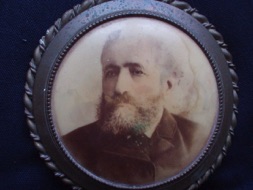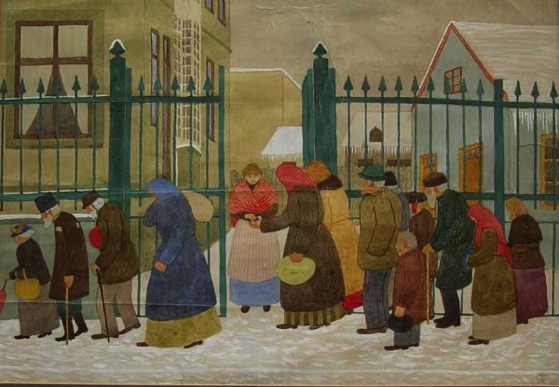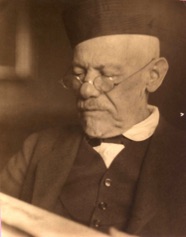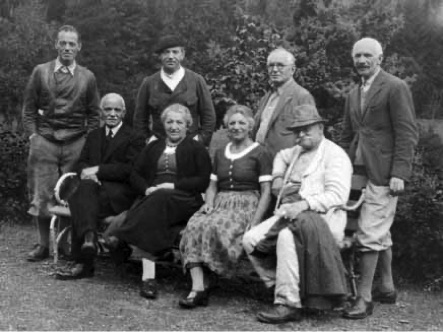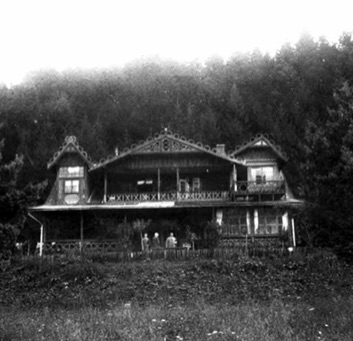Enter Text
Moses Gartenberg, the "Oil King of Galicia," and his Family

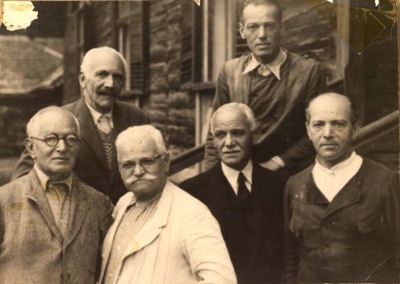
Wolko (Wilhelm) Gartenberg (1884-1950). In this photograph from 1918, he is wearing the uniform of an officer of the Austrian army
Lazar Gartenberg (1833-1898)
Left: Here at Moses' funeral in Vienna in 1917 are his nine surviving children. Left to right: Karolina (Kaile, b. 1862-ca 1942), Ignatz (Isaac, 1867-1944), Alex (Abraham (b. 1868-1934). Arthur (1869-1940. Adele (1878-ca1918), Edi (David (b. 1874), Cecilia (1875-ca 1945), Wolko (Wilhelm) (1884-1950), Fritz (Frederyk, 1890-1945).
Wolko owned several paintings by the celebrated Viennese painter Egon Schiele, including a life size nude portrait of Schiele’s wife that hung behind a curtain in the apartment. Wolko also created his own designs and exhibited some modern rugs in Paris in 1937 and later in New York. Wolko probably lived from his income and was closely involved with the Wiener Werkstätte until the crash of 1928 when he lost his fortune.
The oil boom that began in Borysław in the 1850’s launched an era of industrial expansion in the entire Drohobycz area. The population exploded as people came to find work in the petroleum industry and related businesses. Some Jews became very wealthy, among them, the legendary Gartenberg brothers, Lazar and Moses. Their petroleum empire included oil exploration and production, as well as refining. They built one of the first oil refineries in the area.
Moses and Lazar were the sons of Isak ((1801-1866) and Udel (1803-1869) Gartenberg. The family was long established in Drohobycz and can be traced at least back to the early 1700s. Isak, a brandy distiller, would have been wealthy. His children married into the wealthiest and mst powerful families.
Lazar, eight years older than his brother Moses, was a lumber dealer and probably sold wood for the supports of the early oil excavations after 1854. By around 1863, he had bought a refinery, which processed both oil and wax. His brother Moses joined him. The refinery expanded and for a period of time was the largest in Galicia. The brothers bought other refineries and remained in business until the late 1930s. Both Moses and Lazar expanded their business empires beyond petroleum, in breweries, tobacco, and agriculture. When Lazar died in 1898, their estate was divided among their children.
Above: The six Gartenberg brothers in 1901 in Dębina. Left to right: Alex, Artur, Ignatz, Edi, Wolko and Fritz..
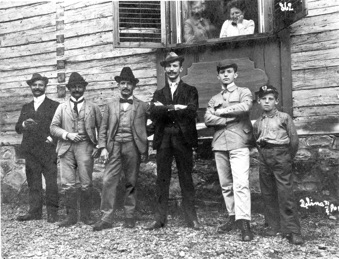
Moses Gartenberg (1841-1916)

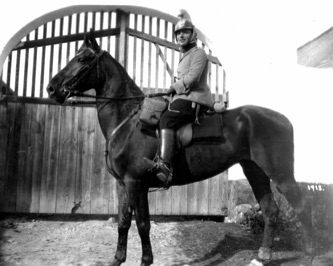

World War I
Moses and Lazar Gartenberg owned many properties, some of them large estates, in the area around Drohobycz and Stryj. They had bought a large tract of land with extensive forests in Dębina where they had a lumber business. There, the brothers also built summer homes that formed a family compound. Even after most of the Gartenbergs had all moved to Vienna, Dębina remained popular for summer holidays and hunting parties.
Wolko and his wife Elda in 1918
Wilhelm, called Wolko, was the second youngest son of Moses Gartenberg. Around 1910 he spent some time in Paris where he developed a strong interest in art and became acquainted with various artists. He served as a cavalry officer in World War I. In 1918, Wolko married his wife Elda. A young cousin who attended the wedding recalled the event much later with all the men in their colourful uniforms and Elda as ravishing beauty.
Wolko and Elda lived in central Vienna in a fashionable apartment that had been owned by his father Moses. It was decorated by the celebrated designer, Dagobert Peche. (See Dagobert Peche and the Wiener Werkstätte, English translation published by Neue Galerie New York, October 2001).
Heinrich (Henko) Gartenberg (1895-1971), the son of Moses Gartenberg's eldest son Ignatz, also served in World War I.
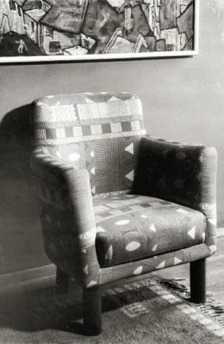
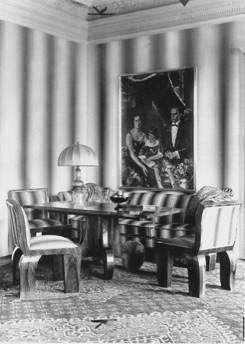
Corner in Wolko's apartment in Vienna
Chair in Wolko's apartment in Vienna
Holidays in the Country
Dębina and Stynawa
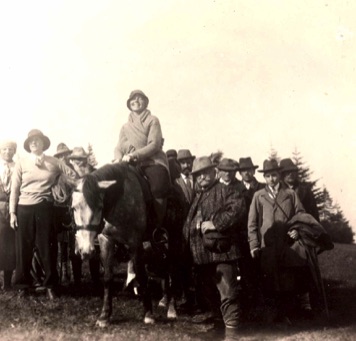
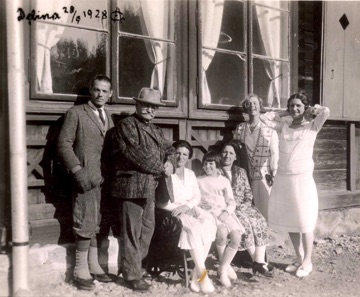
Moses Gartenberg's country home in Dębina
Hunt in Dębina, November 1928
Fritz, the youngest son born in 1890, survived the German invasion in Budapest where he was shot on sight by Russian soldiers when he ran to greet them as they marched to liberate the city. Arthur was a lawyer in Vienna. He married Mathilde von Koerber. After the annexation of Austria by Germany, Artur was banned from practising as an attorney in Vienna and lost his personal wealth through confiscation and the “ flight tax.” He managed to flee to Budapest with his wife, but died soon after in 1940, at the age of seventy. Alex Gartenberg, born in 1869, married Steffie Reiner, seen in this photograph. She had studied with the Austrian painter Egger-Lienz and was an accomplished artist. Alex took up painting and achieved some recognition as a gifted amateur. He died before the war. His wife Steffi survuved.
Fritz, Alexander and Artur Gartenberg in the sunshine of Dębina
At Dębina in 1928, Fritz, Alex, Cecilia, Wolko's daughter Edmee, Adele, Alex's wife, Steffie and Wolko's wife, Elda.
© Valerie Schatzker 2016
This page is hosted at no cost to the public by JewishGen, Inc., a non-profit corporation. If you feel there is a benefit to you in accessing this site, your JewishGenerosity is appreciated. http://www.jewishgen.org/JewishGen-erosity.
World Before and During the Second World War

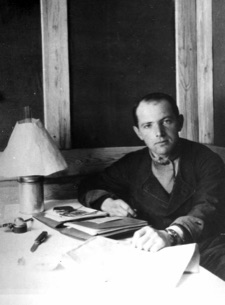
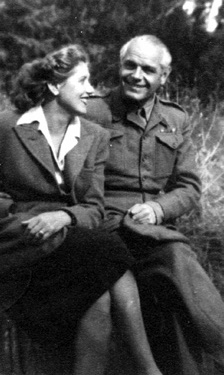


Left: Moses children just before the Second World War in 1937. Standing from left to right: Fritz, Wolko, Artur, Edi. Seated Ignatz, Adele, Cecilia and Alexander. Edi, whose birth name was David, married Muriel Agnes Duschnitz of Australia. They had a daughter, Ottilie, who married John Scott, the British consul in Vienna.
Moses daughters, Adele and Cecilia.
After the 1928 crash, Wolko lived in Kraków and spent the summers in Drohobycz. In the summer of 1939, Wolko’s wife convinced him to return to Vienna because of the impending German invasion. Taking the last train, they managed to reach Budapest from whence they fled to Mexico. In Mexico, Wolko continued his artistic work designing silver artifacts.
The members of the Gartenberg family who remained in the Drohobycz area perished.
Wolko Gartenberg in a photograph taken in Cracow before the war.
In n a photograph taken in Cracow, Wolko is seen with his wife Elda and his daughter Esmée.
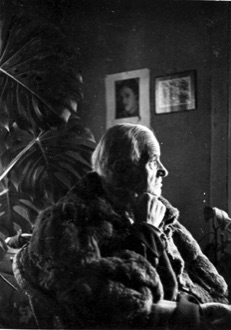
Ignatz Gartenberg (1867-1944
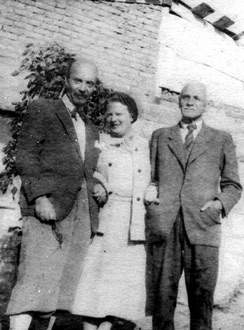
Ignatz Gartenberg with his daughter Ella and her husband, Fritz Reichl.
Ignatz (Isaac), the eldest of Moses’ sons, married Adele Schreyer in 1889. They had two children, a son Henko (Heinrich), and a daughter, Ella. Ignatz was very active in managing the family petroleum interests . Under his direction, new oil wells were drilled and refineries added well into the 1930's.
Ignatz fled to Jasło in Poland just prior to the German invasion. From there, he was able to escape through Romania to Turkey where he joined his daughter Ella and her husband Fritz Reichl, who was working as an architect on the new Turkish Parliament. Ignatz died in Ankara in 1944. After the war Fritz and Ella moved to the USA to join their son, Eric.
Above : Henko Gartenberg, Ignatz's son before the war. Below he is seen after he escaped to London in the 1940's and joined the Polish army in exile.
Moses six sons before the war: Standing from left to right: Artur, Ignatz, Alexander, Edi. Frits, and Wolko.
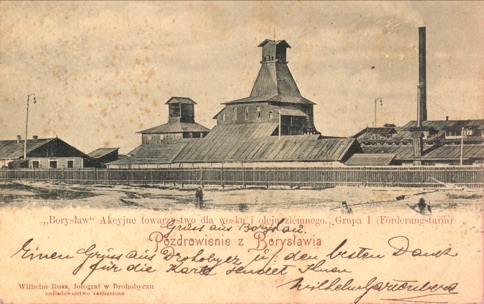
A postcard sent by Wilhelm/Wolko Gartenberg showing a petroleum and wax factory in Borysław.
The photograph is by the Jewish photographer in Drohobycz, Wilhelm Russ (seeThe Family of Wilhelm Russ).
The photographs in this section were submitted by Erik Hågsater, the great grandson of Moses Gartenberg, and the family of Henko Gartenberg.
Moses Gartenberg’s wife was Chaje Tille (Ottilie) Reingewirtz (see The Sternbach Family.) Born in 1843, she was renowned in Drohobycz for her charitable work. Ottilie and her husband were the major donors for the Jewish Hospital and the Jewish Home for the Aged in Drohobycz.
Above: In this watercolour painted in Vienna many years after her death by her son Alexander, Ottilie is portrayed distributing alms to the poor outside her home in Drohobycz.
